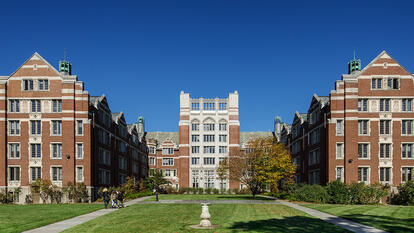Wellesley College Archives Is a Key Teaching and Learning Resource

For his class in plant diversity and ecology, Assistant Professor of Environmental Studies Alden Griffith used plant samples collected by two Wellesley students more than 125 years ago that now reside in the Wellesley College Archives.
The collection, which includes dozens of pressed samples of vegetation that grew on campus a century ago, gave Griffith and his students a valuable repository of information and well-preserved artifacts to study. “There were some species [of plants] that were remarkably well-preserved that the students found fascinating,” he said.
Rebecca Goldman, the College archivist, said Griffith’s experience highlights how the College’s archival material can be used to enrich teaching and learning in classroom. “We are always excited to work with faculty to identify collections in the archives that are relevant to their courses,” she said.
Goldman said she and her colleagues Sara Ludovissy, assistant archivist, and Carla Stewart, cataloging and metadata specialist, regularly receive documents, artifacts, and historical records, and even personal diaries, scrapbooks, and old photos from alumnae and faculty or their friends and family members. “We are not a warehouse. We want things that can be used for research that embody Wellesley throughout its history,” she said.
Indeed, the specimens used by Griffith and his students date back to the late 1800s. Sisters Isabel and Linda Puffer, both class of 1891, loved plants and took botany courses at Wellesley. In 2015, Wellesley purchased their herbarium, which includes samples they collected from the campus grounds as students, from a rare book dealer who had acquired it through a sale and learned that the sisters had attended Wellesley.
When Griffith contacted the archives after learning of the collection from a colleague, Goldman said she and her staff assembled materials from several botanical collections to relate the “experience of studying botany at Wellesley in the late 19th and early 20th century,” in addition to department lesson plans and handwritten lesson notes from students and faculty.
The Puffer collection includes plant specimens that were pressed and carefully pasted onto individual sheets of paper. The sisters recorded the dates they collected the plants and where they found them across the campus and at locations in Plymouth and New York.
Griffith said herbaria like the one created by the Puffer sisters are “like time capsules of data that can shed light on things such as changes in plant populations and communities over time, physiological responses to environment conditions at the time, and the timing of life cycle events such as flowering.”
One of his students, Sarah Smith-Tripp ’19, said she was impressed that the specimens were so pristine. “There was one Trillium grandiflorum, which is my favorite flower, that I particularly enjoyed because it was so well preserved, and looked exactly like the Trillium grandiflorum that bloom every spring on campus.”
Mia Tuccillo ’20 said having access to the collection “allows us to look into the past and be able to map ecological landmarks in time, or see how the ecology of one place can change so much over time.”



